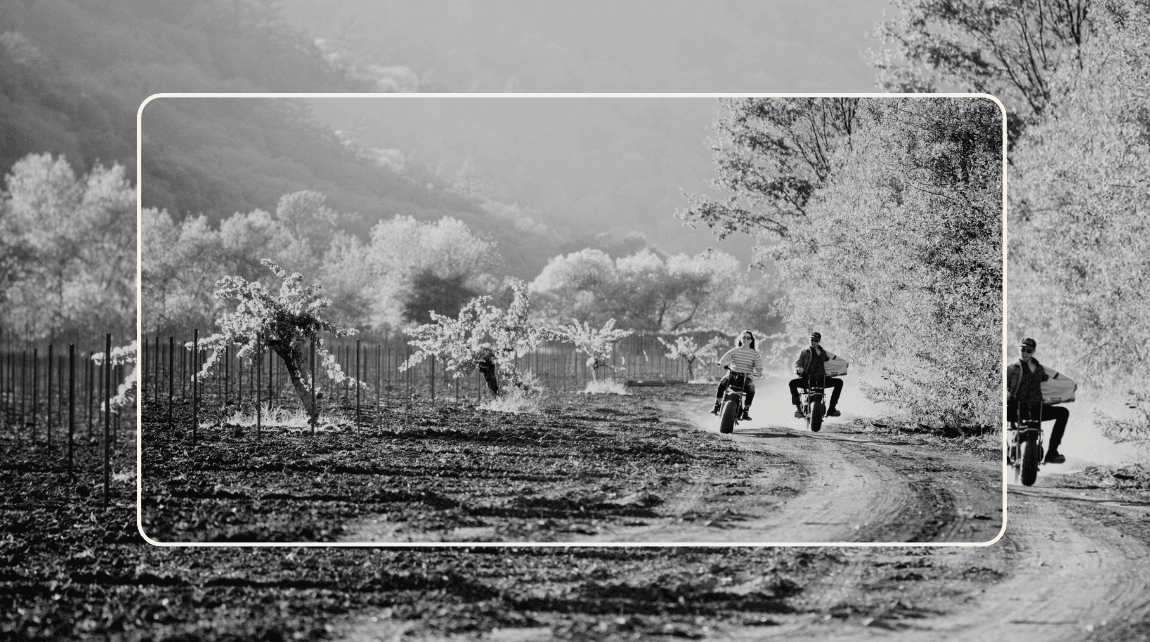
Welcome
Create your free Unicorn account to bid in our legendary weekly auctions.
By continuing, you agree to the Unicorn Terms of Use, Privacy Policy, Conditions of Sale, and to receive marketing and transactional SMS messages.
Already have an account?

Let’s get you approved to bid
To place your first bid, you’ll need to get approved to bid by confirming your mailing address and adding a payment method
Five Natural Winemakers in California You Absolutely Need to Know
The best of California's new wave.
Andrea Jaramillo · May 14, 2024

As is the case for many other regions, natural wine in California has been around much longer than most realize. After all, Tony Coturri often points out that he’s made natural wine since the early 1960s, long before he and his dad officially started up their family’s winery on Sonoma Mountain back in 1979.
But it’s hard to imagine the current wave of California natural wine without Chris Brockway, who started Broc Cellars in Berkeley in 2002. He definitively steered away from the bigger-and-bolder style that then reigned over the region to lean into lighter and more expressive styles—always harvesting a bit early, to preserve freshness and acidity. This, of course, resulted in food-friendly wines with lower ABV that showcased California terroir, and proved tailormade to the farm-and-table ethos that many Bay Area restaurants embrace.
Today, Broc produces more than 20 bottlings, ranging from his playful (but elevated) carbonic Carignan and Cabernet Franc KouKou wines to his Michael Mara Vineyard Chardonnay. He has primarily worked with purchased grapes, although in 2021 he began to farm the Fox Hill Vineyard in Mendocino, known for its Italian varieties like Nero d’Avola and Trebbiano, and became its owner in 2023. Along the way, he’s also spurred interest in vineyards that grew lesser-known grapes. My gateway California natural wine experience was with his Got Grapes, made entirely from Valdiguié—an explosion of bramble and spice that was clean and precise, light on its feet, and exciting with each sip.
Many of the shops and restaurants I frequent in Los Angeles focus their lists on local wineries, highlighting a new crowd of younger and diverse winemakers whose approaches share resonances with Brockway: low ABV, food-friendly, and lifted. California’s natural wine scene continues to evolve, and what follows barely scratches the surface, but a bottle from any of these producers would be a great place to get to know its new generation.
Say When Wine (Lompoc)
A label I go back to, year after year. Say When Wine’s winemakers, Rachel Silkowski and Michel DeAscentiis, work with grapes from the Central Coast’s organic, biodynamic, and regenerative vineyards to make clean, refined, and thoughtful bottles that capture the essence of what California wine can (and should) be. Their most recent vintage included five single-vineyard and single-varietal wines from Central Coast vineyards like Sky Ranch, Laird Vineyard, and Ibarra-Young Vineyard, but one of my favorite wines last year was their 2022 Rosé of Pinot Noir ($22), from Topotero Vineyard. It was a fresh, slightly salty take on a rosé that married creamy strawberry and white peppercorn in a stunning way. Their secondary label Weird Parties, uses semi-carbonic methods and varieties like Grenache and Pinot Noir from Demeter-certified vineyards like Martian Ranch and Spanish Springs to create free-spirited, easy-drinking wines.
Scar of the Sea (San Luis Obispo)
Another Central Coast favorite, with something of a well-deserved cult following. The husband and wife team behind it, Mikey and Giulia Giugni, are revered for their excellence in winemaking, and just as adamant about farming practices. One of my favorites—coincidentally enough—is their Rosé of Pinot Noir ($39), also sourced from Topotero, but made using méthode ancestral, which I opened last Christmas morning. It was clean and crisp, with fine bubbles and a soft strawberry soda-like appeal.
Rootdown Wine & Cole Ranch (Mendocino County )
Rootdown Wine is working to diversify their AVA, Cole Ranch (the smallest AVA in the United States), to include Jura-inspired wines by planting varieties like Savagnin and Trousseau. Mike Lucia’s wines are complex and layered, and typically lean into earth and texture—and somehow also light and breezy with elegant structure. Cole Ranch is also home to 50-year-old Riesling, Merlot, and Cabernet Sauvignon vines; and Rootdown makes a Riesling ($30) that rivals some of the best Alsatian versions I've had. The 2021 Riesling had spiced apple cider on the nose, a lemon bar-like tartness and a creaminess on the palate, alongside the slightest hint of vanilla shortbread that cut through the acid and softened it.
Martha Stoumen (Sebastopol )
The queen of California natural wine, who has managed to scale her winery (she now produces 8,000 cases per year) while maintaining her focus on minimal intervention and California terroir. Her philosophy centers around patience in the vineyard and in the cellar, and emphasizes Mediterranean varieties with a uniquely sunny feel—her wines are truly a joy to drink. I recently shared a bottle of her Negroamaro Rosato ($47), from Mendocino County’s Bricarelli Ranch, and was instantly transported to a sunny afternoon in the fall. There was something equally bright and cozy about this wine, with notes of woodsy florals and herbs, and it paired perfectly with an herby green and pine nut pizza.
Raft Wines (Sonoma County)
The wines made by Raft Wines’s Jennifer Reichardt, whose family has spent five generations as duck farmers in Sonoma County, speak to her lifelong connection and understanding of the land. She spent over 10 years working in vineyards around the world and returned home to create wines that are made with the intention of being served with great food. Her 2021 Sangiovese ($25) lingered in my mind long after the bottle was empty. So many layers of herbs and spice, a bouquet of crushed red roses and tart cherries—a perfect wine to share with friends over a bowl of pasta.

extendedBiddingModal.title
extendedBiddingModal.subtitle
extendedBiddingModal.paragraph1
extendedBiddingModal.paragraph2